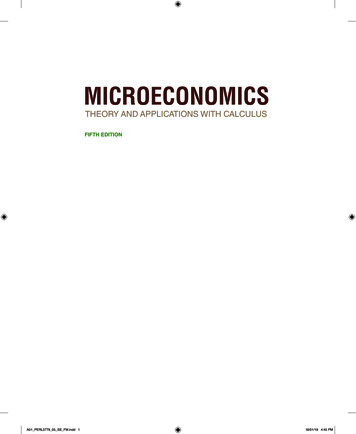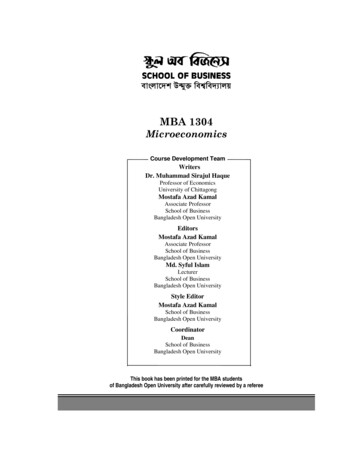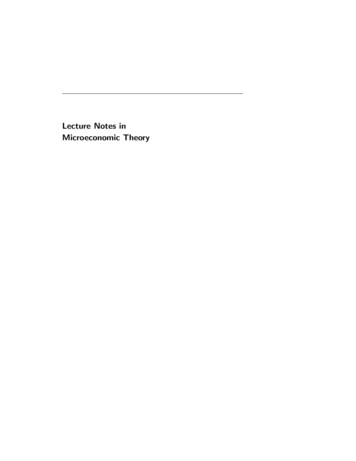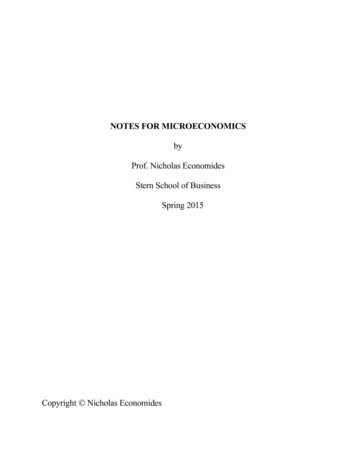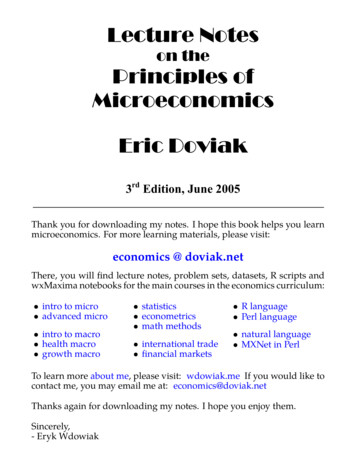
Transcription
Lecture Noteson thePrinciples ofMicroeconomicsEric Doviak3rd Edition, June 2005Thank you for downloading my notes. I hope this book helps you learnmicroeconomics. For more learning materials, please visit:economics @ doviak.netThere, you will find lecture notes, problem sets, datasets, R scripts andwxMaxima notebooks for the main courses in the economics curriculum: intro to micro advanced micro intro to macro health macro growth macro statistics econometrics math methods international trade financial markets R language Perl language natural language MXNet in PerlTo learn more about me, please visit: wdowiak.me If you would like tocontact me, you may email me at: economics@doviak.netThanks again for downloading my notes. I hope you enjoy them.Sincerely,- Eryk Wdowiak
PrefaceMicroeconomics is the study of the behavior of individual households, firms and industries as well as thesupply and demand relationships between producers and consumers.You might think of a household as a consumer, but households are also producers. For example, take alook at your kitchen: you take raw materials (meat, cheese, vegetables, eggs, salt and pepper) as well ascapital (stove and frying pan) and your own labor to produce an omelet, which is demanded by you andmembers of your family. They may not pay you in money, but you’re compensated in other ways.Cooking an omelet for your family is a very simple example of an economic problem. So what’s thepoint? The point is that economics isn’t “all about money.” It’s about life. It’s about human behavior. Infact, economic analysis can be applied to almost any problem imaginable.For example, there is a branch of economics that studies the production of health and the demand forhealth. Notice that I wrote “health” and not “health care.”To take another example, economic analysis can also be used to analyze the war on drugs without evermentioning the word “price.” Instead what is important is “opportunity cost” – what we have to give upwhen we make a choice. In some American cities, police officers are so busy preparing prosecutions thatthey don’t have time to respond to 911 calls. Why? Because the politicians chose to put as many people injail as possible, they actually had to forgo law and order.Studying economics will help you understand the nature of trade-offs that you face in everyday life. If youspend more time studying economics, you’ll be less likely to make decisions that are as stupid as the onesour politicians have made and more likely to make rational decisions.Page 2
Lecture Notes on thePrinciples of MicroeconomicsEric Doviak3rd Edition, June 2005Table of Contents41011131722Lecture 1: Introduction and Math ReviewƇ Homework #1AƇ Homework #1B – More Math Review ProblemsƇ What’s the difference between Marginal Cost and Average Cost?Ƈ Calculus TricksƇ Homework #1C2332Lecture 2: Production, Opportunity Cost and Relative PriceƇ Homework #23443Lecture 3: Supply, Demand and EquilibriumƇ Homework #34554Lecture 4: ElasticityƇ Homework #457Review for the Mid-term Exam61697881Lecture 5: Household Behavior and Consumer ChoiceƇ Examples of Income and Substitution EffectsƇ Homework #5Ƈ A Microeconomic Critique of the War on Drugs869398102Lecture 6: The Production Process: The Behavior of Profit-Maximizing FirmsƇ Economic Thought on Land Value TaxationƇ Notes on Isoquants, Isocosts and the Memo on Land Value TaxationƇ Homework #6104111113Lecture 7: Short-Run Costs and Output DecisionsƇ Why does a Firm Maximize its Profit where Marginal Revenue equals Marginal Cost?Ƈ Homework #7114120122Lecture 8: Costs and Output Decisions in the Long RunƇ Notes on the Zero Profit ResultƇ Homework #8124Review for the Final ExamPage 3
Lecture 1Introductionand Math ReviewEric DoviakPrinciples of MicroeconomicsHelpful hintsxxxxxxEconomics doesn’t have tobe difficultBUT. some people makeit difficult for themselves.I did.If a model is unclear, don’ttry to think of an examplefrom the 10 trillion USeconomy.Instead, apply the model toa small rural village.xMost important part of anyeconomic model are the:ASSUMPTIONSxxxPage 4If you understand theassumptions of the model,you will understand theconclusions.You will NOT understandthe conclusions, if you don’tunderstand theassumptions.WHEN READING, DON’TSKIP CHAPTERS!
Scope & Method of EconomicsWhy should I study economics?xTo learn a way of thinking! Hopefully, you’ll learn to use threekey concepts in your daily lives:o efficient marketso marginalism ando opportunity costEfficient marketsxxxProfit opportunities are rare because everyone is looking for them.Efficient markets eliminate profit opportunities immediately.Ex. You’ll never find a good parking space, because if there was agood one, it would already be taken before you got there.MarginalismAverage cost – total cost divided by quantityxxxIf I spend 300 hours preparing 30 lessons for you:You had better study!My average cost per lesson is 10 hours.Sunk cost – costs that can no longer be avoided because they havealready been “sunk”x If I teach this class again next semester, I will have already sunk300 hours into preparation.Marginal cost – cost of producing one more unitx Next semester I can recycle my notes, so my marginal cost perlesson will equal 75 minutes.x Compare that with my current 10 hours!Page 5
Opportunity CostxxxxxWe all face choices. Resources are “scarce.”We can’t spend more time or money than we have, so we have to give upone opportunity to take advantage of another.If I have a choice between earning 1000 per month by teaching thiscourse OR earning 500 per month by working at McDonald’s, then:o It takes me one month to produce 1000 worth of teaching.o It takes me one month to produce 500 worth of burger flipping.Q: What’s my opportunity cost of teaching?A: Half a burger flipping per unit of teaching.one month 1000 of teachingone month 500 of burger flippingone month per 1000 of teachingone month per 500 of burger flipping 500 of burger flipping 1000 of teaching1 burger flippingsteaching2I’ll give a much, much better example in the next lecture.Point plotting (X,Y):x the first point in a pair lies on theX axis (horizontal axis)x the second point in a pair lies on theY axis (vertical axis)Let’s graph the following equationin red (square points):y –5x 20Connect points:(0,20), (1,15), (2,10), (3,5) & (4,0)y-intercept:x the value of y, when x 0x here it’s 20, because:20 (–5*0 ) 20slope: (we’ll get back to that)More examples:y 4x 5 (blue, round points)y –2x 15 (green, triangle points)Page 6Math – tool ofecon. analysis
equation:y –5x 20y 4x 5y –2x 15slope:– 54– 2y-int:20515Math – tool ofecon. analysisWhat is SLOPE?xthe change in y divided by thechange in xooooxxy –5x 20x increases from 1 to 2y decreases from 15 to 10slope: 10 15 5 52 11positive slope: x and y increaseand decrease togethernegative slope: x and yincrease and decrease inversely(when one rises the other falls)xxWhy does curve slope up?When is avg. consumptiongreater than avg. income?How is this possible?xA statistical estimation ofthe relationship betweenavg. income and avg.consumption is:AC 0.57*AI 13,539NB: in linear functions (such as theones here) the slope equals the valueof the parameter by the variable X.AnalyzingGraphswhere: AC avg. consumptionand AI avg. incomexxWhat’s the significance ofthe y-intercept ( 13,539)?What’s the significance ofthe parameter next to theAI-variable (0.57)?The graph illustrates relationship betweenaverage household income and averageconsumption expenditure. Along the 45degree line, income equals expenditure.Page 7
AC 0.57*AI 13,539marginal propensity to consumeI’m using an example from macroeconomics, because some of you have already takena macro course. If you haven’t Don’t worry. We’re just reviewing basic algebra.xxxIf your boss increased your income from 31,000 to 32,000, how much morewould you consume?o On average, you would consume an extra 570 worth of goods.o Put differently, if you were an average person, your expenditure onconsumption goods would rise from 31,209 to 31,779.Every 1000 increase in income raises consumption by 570. Why?marginal propensity to consume 0.57 (NB: that’s the slope of the line!)xxWhat if you got fired? How much would you consume?Your income would fall to zero, but you’d still consume 13,539 worth ofgoods. After all, you’ve got to eat!xWhen your income is less than 31,486 your expenditures on consumptiongoods exceed your income. (You run down your savings).When your income is more than 31,486 your income exceeds yourexpenditures on consumption goods. (You save some of your income).xA few more definitionsAC 0.57*AI 13,539xxxY C I G (X–M)Model – the formal statement ofa theory, often presented usingmathematical equationsVariable – a measure that canchange such as consumption orincomeo Dependent variableo Independent variableo In the example above,consumption depends onincome.Parameters – values whichremain constant in an equation(here: 0.57 and 13,539)xCeteris paribus – “all elseequal”xHow does an increase ininvestment, I, affect nationalincome, Y?To answer this question we musthold all other variables constant,while we determine the effect ofinvestment alone.xPage 8
Micro vs. MacroxxMICROeconomicsStudy of the decision-makingof individuals, householdsand firmsStudy of distribution ofwealthxxMACROeconomicsStudy of aggregatesWhat factors affect:o Gross Domestic Product?o the price level?o the unemployment rate?Positive vs. Normative EconomicsxxPositiveNo judgementsJust asking how the economyoperatesxxxNormativeMakes judgementsEvaluates the outcomes ofeconomic behaviorPolicy recommendationsEconomic policyxxxPositive – economic policy starts with positive theories andmodels to develop an understanding of how the economy worksThen economic policy evaluates (normative) on the basis of:o Efficiency – Is the economy producing what people want atthe least possible cost? (quantifiable)o Equity – Is the distribution of wealth fair? Are landlordstreating low-income tenants fairly? (non-quantifiable)o Growth – Increase in total output of the economy. Note:efficiency gains lead to growth (quantifiable)o Stability – steady growth, low inflation and full employmentof resources – capital and labor (quantifiable)And recommends (normative) courses of action to policy-makers(presidents, congressmen, etc.)Page 9
Homework #1AI am rewriting these homework problems. Sorry for the inconvenience.Please check back soon.Page 10
Homework #1BMore Math Review Problems1. Graph these equations (placing Y on the verticalaxis and X on the horizontal axis):x Y 2X 2x Y 4X 2Comparing the two equations, which is different:the slope or the Y-intercept? How is it different?Are the lines parallel or do they intersect?2. Graph these equations (placing Y on the verticalaxis and X on the horizontal axis):x Y 2 2Xx Y 2 – 2XComparing the two equations, which is different:the slope or the Y-intercept? How is it different?Are the lines parallel or do they intersect?3. Graph these equations (placing Q on the verticalaxis and P on the horizontal axis):x Q 4 2Px Q 2 2PComparing the two equations, which is different:the slope or the Q-intercept? How is it different?Are the lines parallel or do they intersect?4. Graph these equations (placing Q on the verticalaxis and P on the horizontal axis):x Q 4 – 2Px Q 2 2PThese two equations have different slopes anddifferent Q-intercepts. Do the lines intersect? If so,can you find the value of P and Q at which nd)PQ(1st)Q(2nd)If demand curves slope down and supply curves slope up, then which of these two equations resembles ademand curve? Which resembles a supply curve?5. Solve these two equations for P. Then graph thenew equations by placing P on the vertical axis andQ on the horizontal axis:x Q 4 – 2Px Q 2 2PDo the lines intersect? If so, can you find the valueof P and Q at which they intersect?QPage 11P(1st)P(2nd)
6. The Law of Demand says that consumers purchase more of a good when its price is lower and they purchaseless of a good when its price is higher. Can you give that statement a mathematical interpretation? (Hint: Doesprice depend on quantity purchased? or does quantity purchased depend on price?)Is price an independent variable or a dependent variable? Is quantity purchased an independent variable or adependent variable? What is the difference between a dependent variable and an independent variable?On which axis (the vertical or horizontal) do mathematicians usually place the independent variable? On whichaxis do mathematicians usually place the dependent variable?When economists draw supply and demand diagrams, they usually place price on the vertical axis and quantitypurchased on the horizontal axis. Why is that “wrong”?7. (A question about percentages) 0.750 %8. (A question about fractions)2 %3Page 12
Eric DoviakPrinciples of MicroeconomicsWhat’s the difference between Marginal Cost and Average Cost?“Marginal cost is not the cost of producing the “last” unit of output. The cost of producing the last unit ofoutput is the same as the cost of producing the first or any other unit of output and is, in fact, the averagecost of output. Marginal cost (in the finite sense) is the increase (or decrease) in cost resulting from theproduction of an extra increment of output, which is not the same thing as the “cost of the last unit.” Thedecision to produce additional output entails the greater utilization of factor inputs. In most cases thisgreater utilization will involve losses (or possibly gains) in input efficiency. When factor proportions andintensities are changed, the marginal productivities of the factors change because of the law ofdiminishing returns, therefore affecting the cost per unit of output.”– Eugene Silberberg, The Structure of Economics (1990)Let’s break Silberberg’s definition of marginal cost into its component pieces. First, he ascribes changesin marginal cost to changes in marginal productivities of factor inputs. (By factor inputs, he means factorsof production, like labor and capital).So what is the marginal product of labor and how is it affected by the law of diminishing returns?Imagine a coal miner traveling deep underground to swing his pick at the coal face. The longer he swingshis pick, the more coal he will produce, but it’s exhausting work, so if his boss were to require him towork a double shift, the miner wouldn’t double the amount of coal that he produces.To be more specific, let’s assume that the miner produces an amount of coal equal to the square root ofthe number of hours he works. The tonnage of coal that he produces is his “total product of labor (TPL).”So if he puts in zero hours, he produces zero tons of coal. If he puts in one hour he produces one ton. If heputs in two hours, he produces 2 1.41 tons of coal, etc.tons of coalhours01234coal011.411.732hours'coal 'hours–10.410.320.27If the miner increases the number of hours that he spends mining from one hour to two hours, his outputof coal will increase by 0.41 tons. Increasing the miner’s hours from two to three hours only increases hisoutput of coal by 0.32 tons however. Notice that the additional coal he produces per additional hourthat he works diminishes. This is the law of diminishing marginal returns.Notice also that the table lists the ratio of the change in coal output to the change in the amount ofhours worked. That’s the slope of the total product function, or the “marginal product of labor.”Page 13
Plotting the miner’s marginal product of labor against the amount of hours that he works shows the rate ofoutput change at each amount of working hours.tons of coalhours01234hourscoal011.411.732'coal 'hours–10.410.320.27We don’t need to measure the changes in the miner’s coal output in one hour increments however. In fact,economists are usually more interested in a continuous rate of change. Those of you who have taken acourse in calculus should know that the continuous rate of change in output is simply the first derivativeof the total product function with respect to the number of hours worked.For those of you who have not taken a course in calculus, imagine that we can measure the miner’s totaloutput at each second in time. If we look at how much the miner’s output increases from one second tothe next and divide that change by one second, we’ll have a good approximation of the first derivative.For example, one second is 1 360 of an hour or 0.002778 hours. If the miner works for exactly two hours,then he’ll produce 1.414214 tons of coal. If he works for exactly two hours and one second, then he’llproduce 1.415195 tons of coal. In other words, adding one second to a two hour workday increases hisoutput of coal by 0.000982 tons. The marginal product of labor evaluated at two hours and one second is:2.002778 20.0027781.415195 1.4142140.0027780.0009820.0027780.353431 tons per hourTo see how successively smaller changes in unitsof time (by which output changes are measured)lead to closer and closer approximations to thefirst derivative, consider this graph of truemarginal product (red), the change in output perhalf-hour change in work hours (green) and thechange in output per one hour change in workhours (blue).A table of the data points in the graph is given onthe next page.Now that you know what the “marginal product of labor” is, what do you think “marginal cost” is? It’sthe change in total cost per unit change in output, calculated for an infinitesimally small change in output.Just as the marginal product of labor measures the slope of the total product of labor function, marginalcost measures the slope of the total cost function.Page 14
hourscoaltrue 5'coal 'hrs.'hrs. 0.5–1.410.590.450.380.330.300.280.26'coal 'hrs.'hrs. 1––1–0.41–0.32–0.27Notice also what happens when we sum the last two columns of the table above (i.e. the columns of'coal 'hrs. ). The column listing a time interval of one hour sums to 2, which is exactly how many tonsof coal are produced. The area under the marginal product curve equals total product because increasingthe number of hours from zero to one yields one additional ton of coal per hour, increasing the number ofhours from one to two yields 0.41 additional tons of coal per hour, etc.The column listing a time interval of half an hour sums to 4, which when multiplied by 0.5 hours alsoequals 2 (tons of coal), so once again the area under the marginal product curve equals total product.The column listing the true marginal product of labor sums to 3.1 plus infinity, which at first glanceseems to contradict the results above, but keep in mind that the true marginal product is calculated usinginfinitesimally small intervals of time. So we’d have to multiply infinity plus 3.1 by the infinitesimallysmall intervals of time that we used to obtain the true marginal product to obtain 2 tons of coal. (Inmathematical terms: we could integrate the true marginal product of labor from zero hours to four hours withrespect to the number of hours the miner works to obtain 2 tons of coal).ƇƇƇNow that we understand the law of diminishing returns and the concept of marginalism, let’s reexamineSilberberg’s quote. He says that to produce more output, a firm must hire more factors of production (likelabor or capital) and/or use them more intensively, but such increased utilization reduces the efficiency ofthose factors of production (due to the law of diminishing returns) and raises the marginal cost of output.For example, if the mining company only employs one miner and pays him a wage of 1 and that oneminer is the only factor of production, then producing one ton of coal requires one hour of labor from theminer and costs a total of 1, but producing two tons requires four hours of labor and costs a total of 4.In this case, the marginal cost of increasing output from zero tons to one ton is 1 and the marginal cost ofincreasing output from one ton to two is: 4 – 1 3.So let’s examine a hypothetical firm’s total, average and marginal costs by assuming that it faces a fixedcost of 10 and its variable cost is given by: VC X 3 3X 2 4X , where X is the amount of output thatit produces. Total cost is equal to fixed cost plus variable cost, so: TC X 3 3X 2 4X 10 .In the specification above, the firm’s variable costs increase as the firm produces more output (anddecrease as it produces less), therefore marginal cost reflects changes in variable cost. By definition, thefirm’s fixed costs do not change when it increases or decreases the amount of output it produces, thereforemarginal cost does not reflect changes in fixed cost – because there are no changes in fixed cost.Page 15
In the graph at right, I have drawn a total costcurve running from negative one units of outputto four units of output.Now it should be obvious to you that a firmwould not produce a negative output.I drew the total cost function from negative oneto better show the shape of the curve and becauseI’ll use negative one to approximate the marginalcost at zero units of output.The total cost curve depicted is everywhere increasing as output increases (i.e. is everywhere positivelysloped), but it is not increasing at a constant rate. Initially total cost rises at a fairly rapid rate, but then therate of increase slows, yielding a somewhat flat section. Finally, the rate of increase accelerates again.Since marginal cost is the rate of change in total cost (the slope of the total cost curve), the marginal costcurve will be U-shaped.TCX 3 3X 2 4X 10'TC 'XXTCVCAC–10123210121422–802412–infinite1277 13'X 1–82284423210 1 220If the firm faces a U-shaped marginal cost curve, then at low levels of output, it can increase the marginalproductivity of its inputs by using them more intensively (a possibility I ruled out in the miner example),but at higher outputs, the firm confronts the law of diminishing returns and faces rising marginal cost.The firm also faces a U-shaped average cost curve. The firm’s average costs fall when it increases itsproduction from zero to a moderate amount of output because its fixed cost is spread over a larger amountof output and (to a much lesser extent) because its average variable cost falls as inputs are used moreefficiently (i.e. they yield a higher marginal product).At high levels of output, the firm’s average fixed cost approaches zero, but its variable costs rise rapidlydue to the law of diminishing returns. At high levels of output, marginal cost exceeds both averagevariable cost and average cost, because the averages spread the rising variable cost over the totalamount of output, whereas marginal cost reflects changes in variable cost over small intervals.Finally, notice that the sum of the entries in the column containing the firm’s marginal cost equals 32 –the variable cost. (Ignore the marginal cost of 8 that occurs when the firm produces zero units of output becauseit was calculated by increasing output from negative one to zero). It equals 32 because marginal cost examineschanges in variable cost, so the sum of the marginal costs must equal variable cost at that level of output.Page 16
Calculus TricksCalculus is not a pre-requisite for this course. However, the foundations of economics are based oncalculus, so what we’ll be discussing over the course of the semester is the intuition behind modelsconstructed using calculus.It’s not surprising therefore that the students who do better in economics courses are the ones who have abetter understanding of calculus – even when calculus is not a required part of the course. So if youwant to do well in this course, you should learn a little calculus.ƇƇƇMany times throughout the course, we’ll be discussing marginalism – e.g. marginal cost, marginalrevenue, marginal product of labor, marginal product of capital, marginal utility, marginal rate ofsubstitution, marginal rate of transformation, etc.Whenever you see “marginal ” it means “the derivative of ”A derivative is just a slope. So, for example, let’s say labor is used to produce outputx if TP stands for Total Production (quantity produced),x if L stands for Labor input andx if ' denotes a change,'TPthat’s the change in Total Production divided by the change in Labor.then if I write:'Lx It’s the slope of the total production function.x It’s the derivative of the production function with respect to labor input.x It’s the marginal product of labor (MPL).So if you understand derivatives, you’ll understand the course material much better.ƇƇƇa few preliminaries – exponentsYou should recall from your high school algebra classes thatwhen you see an exponent, it simply means multiply thenumber by itself the number of times indicated by the exponent.x3x x xxx20But what if you see the something like: x ? Well, that’s simplyequal to:x02 2 28222 24212220112 11212 212 2 2121418x x xNow if you divide both sides of the above equation by x:x3x23x1xxx2 22 31Page 17162824222121221422422322222122022 12 222
Similarly, x 1x0x1and x 2xx 1x1xx1x x1x2But what about x 0.5 ? That’s the square root of x : x 0.5By the same logic as before: x 0.51. Ex. 9 0.5x.x . Ex. 16 0.51916413ƇƇƇa few preliminaries – functionsYou may have seen something like this in your high school algebra classes: f x . This notation meansthat there is a function named “ f ” whose value depends on the value of the variable called “ x .”Some examples of functions in economics include:x The quantity of output that a firm produces depends on the amount of labor that it employs. Insuch a case, we can define a function called “ TP ” (which stands for Total Production) whosevalue depends on a variable called “ L ” (which stands for Labor). So we would write: TP L .xA firm’s total cost of producing output depends on the amount of output that it produces. In such acase, we can define a function called “ TC ” (which stands for Total Cost) whose value depends ona variable called “ Q ” (which stands for Quantity). So we would write: TC Q .xA firm’s total revenue from selling output depends on the amount of output that it produces. Insuch a case, we can define a function called “ TR ” (which stands for Total Revenue) whose valuedepends on a variable called “ Q ” (which stands for Quantity). So we would write: TR Q .ƇƇƇderivativesNow let’s return to the original purpose of these notes – to show you how to take a derivative.A derivative is the slope of a function. For those of you who saw f x in your high school algebra classes,you may recall taking a derivative called “f-prime of x,” f c x .What you were doing was you were finding the slope of the functionf x . You were finding how much the value of the function f xchanges as x changes.So let’s define the function: f x 3x 2 and let’s look at how thevalue of f x changes as we increase x by one unit increments.Once again, let ' denote a change.xf x0123031227'f x'x 3915truefc x061218The third column is our rough measure of the slope. The fourth column – entitled true f c x – is the truemeasure of the slope of f x evaluated at each value of x . The values differ greatly between the twoPage 18
columns because we are looking at “large” changes in x as opposed to the infinitesimally small changesdescribed in the notes entitled: “What’s the Difference between Marginal Cost and Average Cost?”Why does it make a difference whether we look at small or large changes? Consider the followingderivation of the slope of f x :fc x'f x'xf x 'x f x'x3 x 'x 2 3x 2'x3 x 'x x 'x 3x 2'x3x 2 6x'x 3 'x 2 3x 2'xfc x3 x 2 2x'x 'x 2 3x 2'x6 x'x 3 'x 2'x6 x'x 3 'x 2 'x'x6x 3'xIf we look at one unit changes in the value of x – i.e. 'x 1 – then the slope of f x evaluated at eachvalue of x is equal to 6 x 3'x which equals 6 x 3 since 'x 1 .If we look at changes in x that are so small that the changes are approximately zero – i.e.: 'x 0 – thenthe slope of f x evaluated at each value of x is approximately equal to 6 x and gets closer and closer to6 x as the change in x goes to zero.So if f x3x 2 , then f c x6x .Since we’ll be looking at infinitesimally small changes in x , we’ll stop using the symbol ' to denote achange and start using the letter d to denote an infinitesimally small change.ƇƇƇcalculus tricks – an easy way to find derivativesFor the purposes of this course, there are only three calculus rules you’ll need to know:x the constant-function rulex the power-function rule andx the sum-difference rule.the constant-function ruleIf f x3 , then the value of f x doesn’t change x as changes – i.e. f x is constant and equal to 3.So what’s the slope? Zero. Why? Because a change in the value of x doesn’t change the value of f x .In other words, the change in the value of f x is zero.So if f x3 , thendf xdxfc x0.Page 19
the power-function ruleNow if the value of x in the function f x is raised to a power (i.e. it has an exponent), then all we haveto do to find the derivative is “roll the exponent over.”To roll the exponent over, multiply the original function by the original exponent and subtract one fromthe original exponent. For example:5x 3f xdf xdxgxdg xdxgc x15x 215x 2fc x4 x1 25x 3 o 3 5x 3 11 111224xo 4x24 x2 x 1 22x2x 1 2the sum-difference ruleNow, say the function you are considering contains the variable x in two or more terms.2x 2 3x 5kxif we define:f x2x 2gx 3x1 3xhx5then:kxf x gx2x 2 3x hx 5Now we can just take the derivatives of f x , g x and h x and then add up the individual derivatives tofind k c x . After all, the change in a sum is equal to the sum of the changes.dk xdxdf xdx dg xdx dh xdxkc xfc x gc x hc xkc x2 2x 2 1 1 3x1 1 Page 2004x 3
Example
Microeconomics is the study of the behavior of individual households, firms and industries as well as the supply and demand relationships between producers and consumers. You might think of a household as a consume



